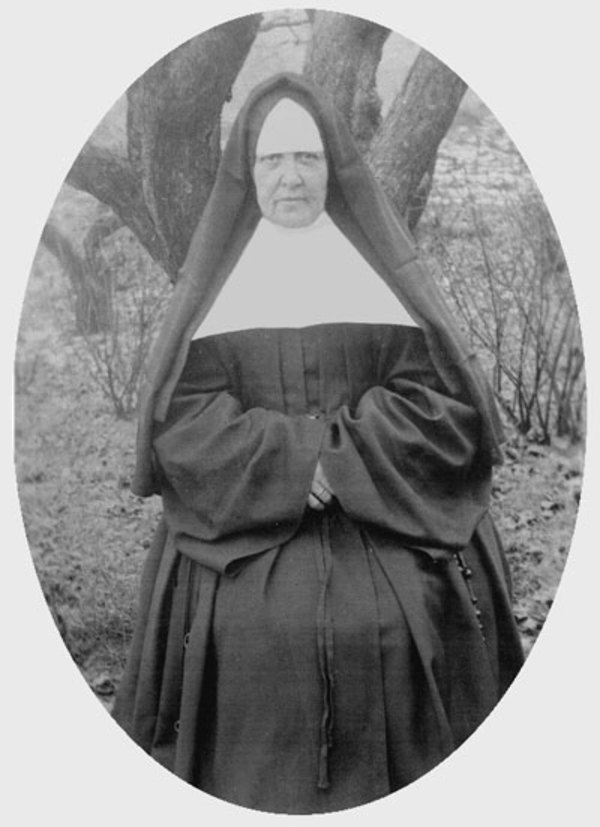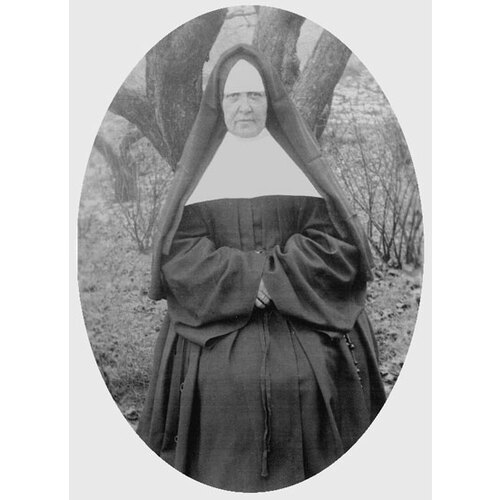
Source: Link
VIGER, AMANDA (baptized Marie-Louise-Amanda), named Saint-Jean-de-Goto, Religious Hospitaller of St Joseph, pharmacist, and founder and director general of the Hôtel-Dieu of Tracadie, N.B.; b. 27 July 1845 in Boucherville, Lower Canada, daughter of Bonaventure Viger* and Eudoxie Trudel; d. 8 May 1906 in Arthabaska (Victoriaville), Que.
Amanda Viger inherited “a fiery disposition” from her father, one of the Patriotes of 1837. Since her parents were relatively affluent, she was able to complete secondary studies at the boarding-school run by the Congregation of Notre-Dame in Boucherville. On 8 Sept. 1860, when she was barely 15, she joined the Religious Hospitallers of St Joseph at the Hôtel-Dieu in Montreal, and on 2 Feb. 1863 she made her profession, taking the name Sister Saint-Jean-de-Goto, which Bishop Ignace Bourget* had chosen for her.
In the hospital dispensary the new sister learned how to prepare and administer remedies. This knowledge would soon prove useful to her, but in a completely different setting. At 23 she went off to Tracadie with five of her companions to succour the hapless victims of leprosy, a malady rife in the region since the second quarter of the 19th century [see Charles-Marie Labillois*; Ferdinand-Edmond Gauvreau*]. Nothing could dissuade her from going, neither her father’s entreaties, nor the awful nature of the disease, nor the sorry state of the lazaret that awaited her. Dr William Bayard, of Saint John, who was staying briefly in Montreal, tried to point out to this “beautiful, educated and refined” young lady “the loathsomeness of the disease and the terrible strain it would be on the nerves of a delicate, sensitive woman.” “I believe my duty lies there,” she is reported to have replied.
On her arrival at Tracadie in September 1868 Sister Saint-Jean-de-Goto set up a small pharmacy that would serve not only the inmates of the lazaret but also those who fell ill in Tracadie and the villages round about. For many years she vainly sought a remedy for leprosy. Elected superior of the Tracadie community in 1875 at the age of 30, she dreamed of building a hospital to house the non-leprous sick who flocked to her dispensary, but in the absence of funds the project was delayed for some 20 years. Meanwhile Alfred Corbett Smith was appointed consulting physician at the lazaret in 1878 and came to help the nuns in treating the lepers. Two years later, after an inquiry conducted on the spot by Dr Joseph-Charles Taché*, the deputy minister of agriculture and statistics in Ottawa, the lazaret was brought under the jurisdiction of the federal government, with Dr Smith as inspecting physician. Sister Saint-Jean-de-Goto had not only given Taché much information about the disease but had also acted as his secretary during the inquiry. As a result of Taché’s report the federal government in the end built a lazaret of stone, and from 8 April 1896 the lepers were accommodated there.
The superior could now devote herself to carrying out her plans for a hospital and orphanage. Since 1873 the religious hospitallers, Sister Saint-Jean-de-Goto included, had looked after children, teaching them in a private school next door to the lazaret. They had been obliged to close it down in 1885, but from 1888 they had none the less continued their educational work, lodging orphans in the attic rooms of the lazaret. Sister Saint-Jean-de-Goto was eager to give them better premises, and, with great ingenuity, she succeeded in collecting the funds to begin building a combined hospital and orphanage. It would be completed in 1898.
In 1899 she finished her fifth term as superior. In addition she had filled the important offices of mistress of novices for 16 years and pharmacist for 28. In the course of her 18 years as secretary of the Tracadie community she had written numerous interesting letters to the mother house that show her to have been a sensitive, intelligent, generous woman endowed with a good sense of humour. The only one of the original members to remain so long at Tracadie – 34 years – she had established a solid foundation for the young community, which by the time of her departure was composed of Acadians who had been trained by her and were ready to take over.
In 1902 Sister Saint-Jean-de-Goto was elected superior of the Hôtel-Dieu of Arthabaskaville (Victoriaville), which had been founded in 1884. She applied herself to extricating it from financial difficulties, and in 1903, although ill with cancer, she undertook to build a new five-storey wing in order to meet the needs of those living in the surrounding area. On 8 May 1906 she died. A strong, courageous, and enthusiastic woman, she had been one of the great figures of the congregation of Religious Hospitallers of St Joseph.
AC, Arthabaska, Qué., État civil, Catholiques, Saint-Christophe (Arthabaska), 10 mai 1906. ANQ-M, CE1–22, 2 août 1845. Arch. des Religieuses Hospitalières de Saint-Joseph (Montréal), Vie religieuse de la communauté, corr, lettres de sœur Saint-Jean-de-Goto à la supérieure de l’Hôtel-Dieu de Montréal, 26 août, 19 déc. 1870; nécrologie de sœur Saint-Jean-de-Goto; procès-verbaux des vêtures et professions, 1858–99; reg. des entrées, 1851–68. Arch. des Religieuses Hospitalières de Saint-Joseph de la Province Notre-Dame de l’Assomption (Bathurst, N.-B.), Vie religieuse de la communauté, chroniques des RHSJ de l’Hôtel-Dieu de Tracadie, fondé en 1868: 131. St. John Daily Sun, 25 Oct. 1887. L’Hôtel-Dieu de Montréal (1642–1973) (Montréal, 1973). F.-M. Lajat, Le lazaret de Tracadie et la communauté des Religieuses hospitalières de Saint-Joseph (Montréal, 1938). Corinne LaPlante, “Sœur Ama[n]da Viger: la fille d’un patriote de 1837, véritable fondatrice de l’H.-D. de Tracadie,” La Rev. d’hist. de la Soc. hist. Nicolas-Denys (Bertrand, N.-B.), 12 (1984), no.1: 5–34. M. J. Losier et Céline Pinet, Les enfants de Lazare: histoire du lazaret de Tracadie (Moncton, N.-B., 1987). Claire Perreault, Les 100 ans de l’Hôtel-Dieu d’Arthabaska, 1884–1984 ([Arthabaska], 1983), 141–56.
Cite This Article
Corinne La Plante, “VIGER, AMANDA (baptized Marie-Louise-Amanda), named Saint-Jean-de-Goto,” in Dictionary of Canadian Biography, vol. 13, University of Toronto/Université Laval, 2003–, accessed December 28, 2025, https://www.biographi.ca/en/bio/viger_amanda_13E.html.
The citation above shows the format for footnotes and endnotes according to the Chicago manual of style (16th edition). Information to be used in other citation formats:
| Permalink: | https://www.biographi.ca/en/bio/viger_amanda_13E.html |
| Author of Article: | Corinne La Plante |
| Title of Article: | VIGER, AMANDA (baptized Marie-Louise-Amanda), named Saint-Jean-de-Goto |
| Publication Name: | Dictionary of Canadian Biography, vol. 13 |
| Publisher: | University of Toronto/Université Laval |
| Year of publication: | 1994 |
| Year of revision: | 1994 |
| Access Date: | December 28, 2025 |



